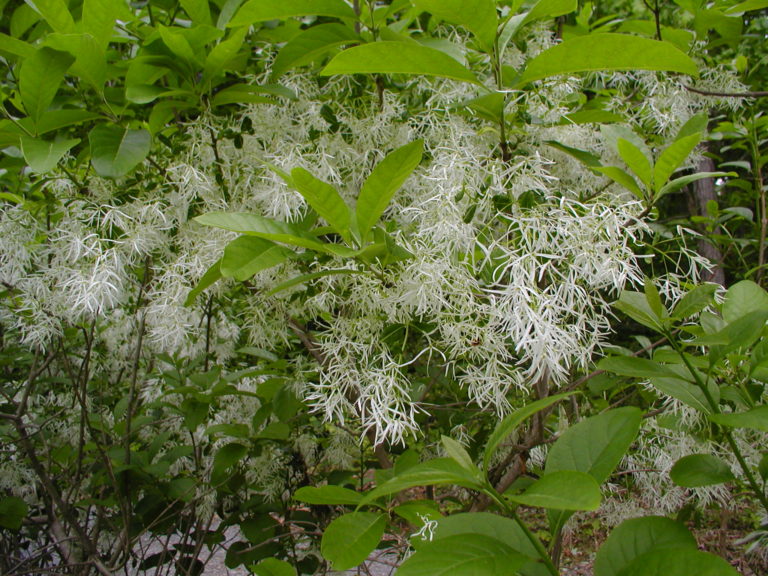Found in moist woods, stream banks, limestone glades and rocky bluffs from Virginia south to East Texas, Fringe Tree is an outstanding ornamental shrub or small tree (twelve to twenty feet) well adapted to our climate in the Carolina piedmont. It thrives in moist, fertile, well-drained soils in full sun to partial shade. The masses of fragrant flowers are extremely showy, frilly white and delicate, appearing in late April to early May just before or with the foliage. Fringe Tree is dioecious (separate male and female plants), with the male flowers very slightly more showy than the female. However, the female plants sport attractive, bluish-black, olive-like fruit in clusters in the late summer, attracting birds such as Cardinals, Bluebirds, Mockingbirds, Woodpeckers. In addition, the foliage hosts many butterfly and moth larvae (caterpillars), including several Sphinxes. Fringe tree has no serious pest or disease problems. With the decline of our beloved Dogwood, Frige Tree is being called upon to provide bright white flowers on a small tree form in suburban landscapes. It is very useful in urban plantings as it is tolerant of air pollution.
NURSERY HOURS
Wednesday: 10-4 Thursday: 10-6 Friday-Saturday: 10-4 Sunday: 12-4
Chionanthus virginicus

Key Info
Scientific Name: Chionanthus virginicus L.
Common Names: Fringe Tree, Flowering Ash, Grandfather Graybeard, Grancy Graybeard, Greybeard, Old Man's Beard, Snowflower Tree, White Fringetree,
Family Names: Oleaceae (Olive Family)
Plant Type: Tree / Shrub
Leaf Retention: Deciduous
Flower Color: White
Special Characteristics: Tolerates urban pollution, Showy fruit (female), Attracts butterflies, Attracts birds, Flowers fragrant
Additional Info
Habit: Small tree or large shrub with a spreading, rounded crown.
Height: 12'-20'
Spread: 12'-20'
Soil Conditions: Loose, moist, sandy soils; grows well on our acid, clay-based native soil at the nursery.
Leaves: Opposite, simple, leathery, ovate to elliptical, 4 to 8 inches long, pinnately-veined with a smooth margin, green above and paler below.
Flowers (or reproductive structures: Dioecious. Drooping panicles of fragrant flowers up to 8" long x 6" across are produced from the axils of last year's leaves. Each panicle is divided into several clusters of flowers, each flower with 4 long, white, twisty petals held in place by a tight, green calyx. Male and female flowers appear similar at a distance, the petals being somewhat longer on the male.
Fruit: Dark bluish-black drupes (berries) maturing in late summer.
Natural Distribution: Moist woods, thickets, bluffs.
USDA Hardiness Zone: 3 to 9
USDA Wetland Indicator Status in NC: FAC (FACU on coast)
Pollination: Butterflies, hummingbirds
Wildlife Connections: Birds and mamals eat berries, deer eat leaves; larval host for Rustic Sphinx.
Propagation: By seeds (need double stratification).
